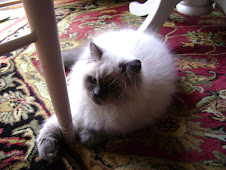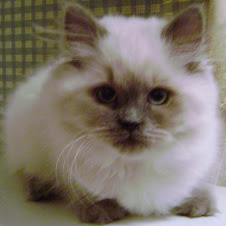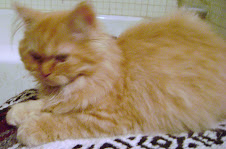
**********************************************************
When a litter is born and the mother is incapable or unwilling to nurse her kittens, a surrogate mother sometimes can be successful in keeping them alive. In other cases, where the infants are not developed fully, the results will not be successful.
Cats are very loving creatures and if you have another female in your home with kittens, she usually can be persuaded to nurse any kittens (or indeed animals of other species) as well as her own. For example, there are countless cases of queens who have adopted a orphaned puppy.
Unfortunately, purebred cats tend to be more fragile than mixed breeds and a first litter for a young purebred cat can be a tragedy. Professional breeders therefore often separate their males and females until the female is older. If one has only two cats who are deeply devoted to one another, it might be too cruel to separate them.
In the case of Beauty, she and Ashleigh are extremely close to the point where one cannot be out of sight of the other without crying. When she went into heat for the first time, he appeared to be utterly indifferent to this new development and showed absolutely no signs of knowing how to take affirmative action. Beauty showed no signs of pregnancy afterwards. I was utterly shocked when she went into labour. Having celebrated her first birthday in June, if she had not been a purebred, she probably would have had little trouble in delivering a healthy litter, although first litters tend to be smaller than subsequent ones. She is a purebred, however, and her labour lasted three days. Amazingly, she showed little distress during this lengthy and prolonged ordeal, although she understandably was more dependent on me than usual. Ashleigh was paralysed with terror by the entire business and would not even approach the kittens. As he is a large cat, his cowardly attitude, although not unusual in Himalayans, is almost comical but of course, when a child exhibits fear, even if the 'child' is a cat, one can't laugh at that genuine emotion, however unmerited the fear may be.
Two kittens were stillborn, one of which was extremely premature. Of the other two, both were premature but fully formed, at least outwardly. They did not breathe easily, however, even at birth, although they were able to cry and thrash about a little.
What further confused me initially was Beauty's odd behaviour where nursing was concerned. She would facilitate it by rolling into position and welcoming the kittens but as soon as a kitten approached a nipple, she would move out of reach and then walk away. Later, I came to realise that this was due to the fact that her labour had not ended. Obviously, contractions were encouraged by any stimulation in that general area. Once I realised that, I massaged her stomach frequently throughout the long weekend. At the same time, I took on the responsibility of feeding the two live kittens myself. Unfortunately, between the birth and the realisation that Beauty actually was not nursing the kittens properly, some time had elapsed as in the beginning, she would assume a nursing position and the kittens then would be comforted and no longer cry.
Tube feeding would have been the optimum solution although I have tube fed premature kittens in similar circumstances who ultimately died. Other kittens I have tube-fed, including one with a cleft palate, lived and thrived.
Since my accident in June, however, I have had neither transportation nor good physical mobility. Furthermore,the automobile accident has proven very costly. The fact that the delivery of the kittens coincided with a weekend made the situation more complicated. One could not simply toss them into the lap of a veterinary clinic, thereby delegating responsibility both for life and death.
With some KMR on the way but not yet in sight, I looked for a good recipe for formula using common household ingredients.
There apparently is a formula commonly known as 'Kitten Glop'. I found a number of recipes for this.
In the past, I created a formula for kittens who had to be fed using the following:
evaporated milk or KMR
purified water
infant 'chicken' or 'turkey' commercial baby food
I mixed these together to form a thin liquid and then fed it to the kittens using a feeding syringe or feeding tube if the kitten were unable or unwilling to swallow.
The 'Kitten Glop' includes more ingredients, however:
glucose in the form of corn syrup
plain yoghurt
'Pedialyte', a liquid for human infants that provides energy and nutrients
mayonnaise
beaten egg yolk (but can be dangerous because of salmonella)
If you can persuade the kitten to stay in a position close to an ordinary nursing position, on his/her stomach, so that it can 'knead' with its little paws, that is best, but the main goal is to get the food into it. (I am using 'it' for simplicity only.) Make certain that the syringe or tube is clear of air bubbles and feed the mixture to the kitten very slowly. Whether you use the syringe by itself or with the tube attached to it, this can be difficult as the plunger will begin to stick, especially if you use the same syringe more than once. You have to be very careful and very patient... If bubbles come from the kittens nose, you are feeding him/her too quickly.
A healthy kitten will use its tongue a little and you will see it swallow but when a kitten begins to 'shut down', often it will not swallow any longer. Tube feeding may revive it or it may not do so.
The beauty of tube-feeding is that it does not require a kitten's active participation. Very often a premature or weak kitten will lose the will to fight. Tube-feeding overcomes this by directing the food into the stomach. There are dangers, however.
To prepare the tube, lay it against the kitten and measure to the last rib, making certain that you wrap a piece of tape or something else that will allow you to 'save' that point on the tube for reference. You should never insert the tube beyond that point when feeding the kitten. Insert the tube very slowly and gently, never forcing it if it does not move effortlessly, and never insert it beyond the point you have marked.
Make certain, whether feeding with syringe only or with tube and syringe that your mixture is warm, but not hot. A little warmer than room temperature will imitate the queen's milk best. Cold formula is nasty and does not sit well in the kitten's digestive system, nor will it appeal much to a kitten who can swallow voluntarily.
When you warm the milk, a microwave can be dangerous as it does not heat all of the liquid consistently. If you use one, stir the liquid well afterwards and test it with your wrist or finger the way you would test baby formula for a human infant.
Warmth is essential, not only with respect to the food but to the kitten's environment. If your Queen will stay with her kittens, even while not actively nursing them, this is best. Kittens instinctively wish to be close to their mothers and I believe that they gain spiritual strength from that contact as well as physical comfort. If the Mother cannot settle with her kittens, however, the situation may vary according to the number of kittens in the litter. If you have a large litter of six or more kittens, they can pile together for warmth in a box that is lined with warm materials (but make certain that a kitten cannot be 'lost' in the fabrics to suffocate). If you have pieces of genuine or synthetic fur, that would be even better, retaining warmth and simulating the real mother's body. If there are only one or two kittens, it may make sense to assume total control of them, especially if the Queen will not remain with them. You then should use a heating pad beneath the fur/fabric in the box to keep the kitten warm.
In Beauty's case, the kittens became very cold at one point because I did not realise that she would not stay with them and that she was NOT nursing them. This would not have occurred if I had taken them from her immediately but she appeared to want them and she always went into the proper nursing position and took an interest in them temporarily.
Kittens will respond to warmth. Try not to wrap them in fabric that can cause danger of stifling them and if you use a heating pad, make certain that there is fabric on it, and that the setting is low, and will not burn the little creatures.
There is one other area where your services will be required. You need a warm wet cloth to stimulate the kitten's nether regions after each feeding. A Mother Cat will use her tongue to stimulate her kittens to eliminate... if she cannot or will not do this, you must do it for her, not with your tongue of course, but with a warm wet flannel. Be gentle and use only soft materials as you will have to do this a few times every day. If the area becomes red and sore, you can use a little petroleum jelly, again as you would for diaper rash.
If you are placed in care of the life of a newborn kitten, you should feed him/her at least six times per day, both during the day and the night but do not overfeed. The kitten's tummy should be plump and yet still soft after feeding, never distended or hard. It is safer to underfeed a little with each feeding than to overfeed.
The bonding that occurs between a surrogate human mother and newborn kittens who require sustenance is incredibly strong and rewarding if the kitten survives. If the kittens do not survive, the pain of loss may be tremendous but I believe it always is better to fight for their lives than to simply shrug and leave it to fate.
One final point should be made here. In a situation where you have newborn kittens, their mother and another cat or cats, you must take care not to neglect the 'other cat/cats' during the 'emergency' period. Unlike Beauty and her babies, Ashleigh was in no physical danger, but his entire universe was turned upside down. He is not a courageous or adventurous cat by nature. The introduction of this drama into his life was very unsettling for him. I tried to remember to pet him and speak to him even when consumed with worry for Beauty and the kittens.
Once I had a male chocolate point Himalayan nicknamed 'Pi' who was extraordinary in that HE would adopt any creature who appeared to need comfort, including newborn kittens. When my bluepoint female, Isis, became to weak to nurse her litter of six shortly after delivery, I had to take her into hospital. During the week she stayed in hospital, I fed her six babies myself. That was an enormous task, as each time I finished feeding the last of the six, the first would be ready to be fed again.
The amazing thing was Pi's response in this situation. He promptly moved into the box with the kittens and went into a 'nursing' position. He had no milk, of course, but he gave them warmth and comfort. He was not even the father, incidentally, but he acted as both mother and father to these kittens inasmuch as he cuddled them and licked them clean after each feeding.
Incidentally, the entire litter survived and thrived. Isis, when she came back from hospital, still could not nurse her babies but she would spend time with them, when Pi allowed her to do so.
Poor Ashleigh, who IS the father of Beauty's kittens, could not even go near them. Gazing up at me in absolute panic with his huge blue eyes, I felt bad for him, knowing he was entirely out of his depth.
One fact about cats or any other pet is that each one is different. You cannot expect the same responses from every cat you have. Some females are natural mothers but others are not.
The first two Himalayan females I had were a sealpoint and a bluepoint. They both had kittens on the same day. Anastasia was a natural mother. She created a nest for herself and proceeded to have her kittens one by one, cleaning them thoroughly then settling to nurse them. Princess, on the other hand, wouldn't make a nest, nor would she look at the nest I made her. She leapt onto my bed and had her kitten in my lap. I had to clean the the little boy, cut the cord and deal with the afterbirth. When I firmly placed her and the kitten in the nest I had made, she promptly grabbed him by the scruff of the neck and deposited him in my lap again! She had no intention of assuming ANY responsibility for her child.
It was Anastasia who noticed the new kitten and who became agitated by its cries. She left her own kittens to find the kitten on the bed. She then took him by the scruff of the neck, leapt off the bed and deposited him in the box with her own kittens. All of the babies prospered in Tasie's care, but Princess never showed the slightest interest in ANY of them.
People who think of cats as being 'cold' have no real knowledge of the species. My cats always have been very sensitive where my own moods are concerned. If I am in pain or upset, they try to comfort me. They are far more aware instinctively than many humans.
Cats can be very selfless as well. When Isis' kittens grew old enough to eat proper food, she would stand aside until each had eaten his/her fill. No matter how hungry she might be, she never would touch the food until every one else had eaten. Mind you, I never let them become REALLY hungry, but it was the same when I offered treats. She would wait until the kittens had been satisfied and only then would accept a treat from me.
Photograph of Friendship, consort of Isis and father of her Kittens. He was rather small and delicate in appearance but quite a stud!




No comments:
Post a Comment